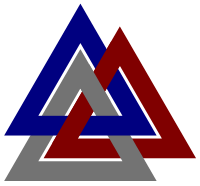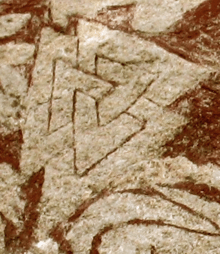Valknut

.png)

The valknut (Old Norse valr, "slain warriors" and knut, "knot") is a symbol consisting of three interlocked triangles, and appears on various Germanic objects. A number of theories have been proposed for its significance.
The name valknut is an unattested modern invention used to describe the symbol, and was not used contemporaneously with the symbol. The valknut has been compared to the three-horned symbol found on the 9th-century Snoldelev Stone, and may be related to it.[1]
In Norwegian (Bokmål) the term valknute is used for a polygon with a loop on each of its corners.[2] In the English language the looped four-cornered symbol is called Saint John's Arms.
Traditional forms
The historically attested instances of the symbol appear in two traditional, topologically distinct, forms. The symbol appears in unicursal form, topologically a trefoil knot also seen in the triquetra. This unicursal form is found, for example, on the 7th century Tängelgårda stone on the island of Gotland, Sweden. The symbol also appears in tricursal form, consisting of three linked triangles, topologically equivalent to the Borromean rings. This tricursal form can be seen on one of the Lärbro stones, also on Gotland, Sweden, as well as upon a ring found in the River Nene in England, and on a bedpost found within the 834 Oseberg ship burial from Slagen, Norway. Although other forms are topologically possible, these are the only attested forms found so far.
Theories
Hrungnir's heart
Chapter 17 of the 13th century Prose Edda book Skáldskaparmál contains the following description of the heart of the Jötunn Hrungnir; "Hrungnir had a heart that was famous. It was made of hard stone with three sharp-pointed corners just like the carved symbol hrungnishjarta [Hrungnir's heart]."[3] Comparisons have been made between this symbol description and the symbol known as the valknut.[1]
Odin and mental binds
Hilda Ellis Davidson theorizes a connection between the valknut, the god Odin and "mental binds":
For instance, beside the figure of Odin on his horse shown on several memorial stones there is a kind of knot depicted, called the valknut, related to the triskele. This is thought to symbolize the power of the god to bind and unbind, mentioned in the poems and elsewhere. Odin had the power to lay bonds upon the mind, so that men became helpless in battle, and he could also loosen the tensions of fear and strain by his gifts of battle-madness, intoxication, and inspiration.[4]
Davidson says that similar symbols are found beside figures of wolves and ravens on "certain cremation urns" from Anglo-Saxon cemeteries in East Anglia. According to Davidson, Odin's connection to cremation is known, and it does not seem unreasonable to connect with Woden, the god of the dead in Anglo-Saxon England. Additionally, Davidson proposes further connections between Odin's role as bringer of ecstasy with the etymology of the names Wodan (related to wut, "high mental excitement, fury, intoxication, or possession") and the later Oðinn (from the adjective óðr meaning "raging, furious, intoxicated").[4]
Other
Due to the Norwegian name for the symbol, valknuter, and the fact that the symbol appears on picture stones with Odin and on burial gifts in the Oseberg ship burial, Rudolf Simek states that the symbol may have been associated with religious practices surrounding death.[1]
Topology
The valknut is topologically equivalent to either the Borromean rings, the trefoil knot, or (in modern use only) a closed 3-link chain, depending on the particular artistic depiction:



 As Borromean rings on the Stora Hammars I stone
As Borromean rings on the Stora Hammars I stone
Modern use
The valknut symbol plays a role in modern Germanic Neopagan faiths, where numerous explanations and interpretations of the symbol are given, has been used by various political groups, and sometimes sees use in modern popular culture. Examples of usage include the Swedish pulp and paper manufacturer and consumer goods company Svenska Cellulosa Aktiebolaget's use of a triquetra valknut as their logo, which can be commonly seen on many products produced by the company. The Deutscher Fußball-Bund (DFB) has (since 1991) used a logo for the German national football team inspired by the unicursal form of the valknut.The symbol is also used as a logo for the Tau Kappa Epsilon Fraternity. [5] The symbol appears as the fretboard inlay on some of Arch Enemy/Carcass guitarist Michael Amott's signature Dean Guitars "Tyrant" models. It is also used as a logo by American engineering firm RedViking. [6] The symbol, like many others associated with Germanic neo-paganism, is used by some white supremacists[7][8] but is not generally regarded as objectionable.[9]
See also
Notes
| Wikimedia Commons has media related to Valknut. |
- 1 2 3 Simek (2007:163).
- ↑ Municipal arms for Lødingen, blazoned in the Norwegian Royal Decree of 11 May 1984, quoted in Hans Cappelen og Knut Johannessen: Norske kommunevåpen, Oslo 1987, page 197. The term is also used in Anders Bjønnes: Segltegninger fra hyllingene i Norge 1591 og 1610, Oslo 2010, pages 64–65.
- ↑ Byock (2001:88).
- 1 2 Davidson (1990:147).
- ↑ DFB home page (German).
- ↑ RedViking home page.
- ↑ "Hate on Display™ - Hate Symbols Database: Valknot". Anti-Defamation League.
- ↑
- ↑ "Symbole und Zeichen der Rechtsextremisten" (PDF). Bundesamt für Verfassungsschutz. May 2013. Retrieved 27 November 2013.
References
- Byock, Jesse (trans.) (2006). The Prose Edda. Penguin Classics. ISBN 0-14-044755-5.
- Davidson, H. R. Ellis (1990). Gods and Myths of Northern Europe. Penguin Books. ISBN 0-14-013627-4.
- Simek, Rudolf (2007), translated by Angela Hall. Dictionary of Northern Mythology. D.S. Brewer. ISBN 0-85991-513-1.